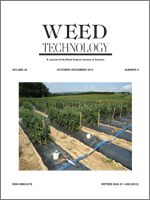Weed control by heat or flaming typically uses flames to burn small weeds, directed away from desired crops. This research studied an enclosed flaming system for weed control before turfgrass establishment. Field research trials were conducted to explore the efficacy of a PL-8750 flame sanitizer at two application timings. Treatments included various application methods of PL-8750 flame sanitizer and common thermal and chemical weed control methods. Data were weed control relative to the control treatment. Species evaluated included carpetweed, Virginia buttonweed, spotted spurge, large crabgrass, goosegrass, old world diamond-flower, cocks-comb kyllinga, and yellow nutsedge. Turfgrass establishment was not successful in summer but was successful in fall. Fall-application timing trials resulted in > 60% tall fescue establishment at 6 wk after seeding (WAS) for all treatments. Summer-application timing trials resulted in unacceptable turfgrass establishment (≤ 18%) for all evaluated turfgrass species at 6 WAS. Broadleaf and grassy weeds were better controlled compared with sedge weeds. Overall, solarization; covered, emerged-weed flaming; and double applications of covered, emerged-weed flaming were the most successful treatments. Solarization controlled carpetweed, Virginia buttonweed, spotted spurge, large crabgrass, and goosegrass > 80% at 6 WAS. Weed control across thermal treatments were equal to or greater than the comparison chemical treatment (dazomet at 389 kg ha−1). Results indicate thermal weed control has potential for reducing weed populations before turfgrass establishment.
Nomenclature: Basamid; dazomet; carpetweed, Mollugo verticillata L. MOLVE; cocks-comb kyllinga, Kyllinga squamulata Thonn. ex Vahl; goosegrass, Eleusine indica (L.) Gaertn. ELEIN; large crabgrass, Digitaria sanguinalis (L.) Scop. DIGSA; old world diamond-flower, Oldenlandia corymbosa L. OLDCO; spotted spurge, Chamaesyce maculata L. EPHMA; Virginia buttonweed,Diodia virginiana L. DIQVI; yellow nutsedge, Cyperus esculentus L. CYPES; tall fescue, Lolium arundinaceum (Schreb.) S.J. Darbyshire.
El control de malezas por calor o llamas usa típicamente llamas para quemar malezas pequeñas al tiempo que se evita el cultivo deseado. Esta investigación estudió un sistema cubierto de llamas para el control de malezas antes del establecimiento del césped. Se realizaron estudios de campo para explorar la eficacia de un desinfectante de llama PL-8750 en dos momentos de aplicación. Los tratamientos incluyeron varios métodos de aplicación del desinfectante de llama PL-8750 y métodos comunes de control de malezas térmico y químico. Los datos fueron control de malezas relativo al tratamiento testigo. Las especies evaluadas incluyeron Mollugo verticillata, Diodia virginiana, Chamaesyce maculata, Digitaria sanguinalis, Eleusine indica, Oldenlandia corymbosa, Kyllinga squamulata y Cyperus esculentus. El establecimiento del césped no fue exitoso en el verano, pero sí lo fue en el otoño. Los estudios de momento de aplicación en el otoño resultaron en un establecimiento >60% de Lolium arundinaceum a 6 semanas después de la siembra (WAS) para todos los tratamientos. Los estudios de momento de aplicación en el verano resultaron en un establecimiento inaceptable del césped (≤18%) para todas las especies de césped evaluadas a 6 WAS. Las malezas de





